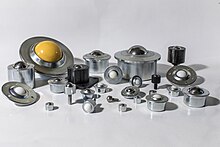Ball caster
Ball transfer units are a special form of roller bearing that are mainly used in conveyor technology . The conveyor roller for the goods to be transported rolls on a ball bed with a dome-shaped support shell. Ball transfer units enable objects to be conveyed to move in any direction in the plane.
commitment
Ball transfer units are suitable for the transport of products and goods that require the option of all-round horizontal movement and rotation around the vertical axis. They guarantee low-friction and highly resilient transport of goods. Fast changes of direction can be implemented. Ball transfer units are characterized by high temperature tolerance and shock resistance. For some uses, ball transfer units in the form of ball roller tables are used.
By using different materials, a wide range of uses of the ball transfer units is possible. They are not only used in conveyor technology, but also in mechanical and plant engineering, medical technology and other industrial sectors.
construction
Ball transfer units consist of a steel or sheet steel housing with an embedded or integrated ball socket. This contains a large number of support balls which enable the support ball to rotate with little friction in all directions. During the movement, the support balls roll off in the ball socket. The structure of the ball transfer units ensures maximum load capacity and even rolling in every installation position (with a few exceptions, the load limit is reduced for overhead installation). Most ball transfer units have a drain hole.
Materials
Housing, cover, bearing shells and other built-in parts are made of steel; Housing and cover are galvanized or burnished . The standard range of some designs also includes ball transfer units made entirely of corrosion-resistant steel (1.4301).
All built-in parts on which the balls move are hardened (except for ball transfer units with a countersunk sheet steel housing). Hardened balls made of roller bearing steel (1.3505) or corrosion-resistant steel (1.4034) are used as standard. Furthermore, it is possible to use plastic support balls (POM) for goods with sensitive surfaces. Other materials (PTFE, ceramic, ...) can be used for special applications.
burden
To determine the load on a ball transfer unit, the weight of the conveyed item is divided by 3. The result is the maximum dynamic load on a ball transfer unit. The stability of the cargo floor has a particular influence on this. In the case of structural unevenness, constant shock-like overloading (lateral impact of the load) can greatly reduce the service life of the ball transfer unit. In practice, depending on the stability of the conveyed goods, significantly more ball transfer units must be used than the theoretical load-bearing capacity calculation shows.
division
The distance between the ball transfer units is calculated by dividing the smallest base dimension of the conveyed goods by 3.5. This guarantees that at least 3 ball transfer units in the x and y axes always carry the load. This prevents the load from tipping or tilting.
Conveyor speed
Depending on the design of the ball transfer unit, conveyor speeds of 1–2 m / s are recommended. Briefly higher speeds up to twice as much are possible.
Temperature range
Ball transfer units with steel balls can be used in a temperature range from −30 ° C to +100 ° C. Ball transfer units with plastic balls can be used up to +30 ° C. At higher temperatures, structural changes to the ball transfer units are necessary and a reduced dynamic load is to be planned. Furthermore, the felt sealing ring should not be used at temperatures above 50 ° C.
Web links
Individual evidence
- ↑ Schulz Stanztechnik GmbH: Technical data Schulz ball transfer units. In: www.kugelrolle.de. Schulz Stanztechnik GmbH, 2017 (German, English, French, Spanish).
- ↑ Brockhaus Encyclopedia in twenty volumes . Volume 11, 1970, p. 36.
- ↑ a b Stefan Hesse: Basics of handling technology. Carl Hanser Verlag GmbH Co KG, Munich 2016, ISBN 978-3-446-44432-4 , p. 511.



